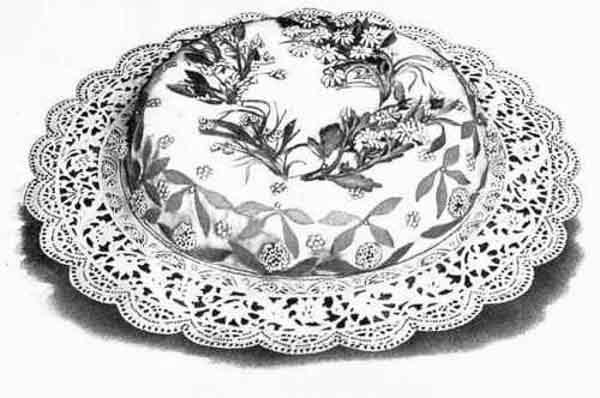
Easter Cake With Candied Violets And Pistachio Nuts
‘The natural colors of violets and pistachio nuts unite to furnish a most attractive and somewhat showy decoration.
Wash a cup of butter in cold water to remove the salt, pat until the water is removed, then beat to a cream and beat in gradually a cup of fine granulated sugar; add a portion of the whites of eight eggs beaten dry and two cups of sifted flour, sifted again with two level teaspoonfuls of baking powder; flavor with a teaspoonful of vanilla and a scant half teaspoonful of almond extract or with a teaspoonful of violet extract; then beat in the rest of the whites of the eggs. Bake in a round sponge cake pan with a tube between forty and fifty minutes. When cold, ice with confectioner’s icing flavored with lemon juice; decorate with a wreath of candied violets and blanched pistachio nuts.’ (Sotoyome Scimitar, 1904)
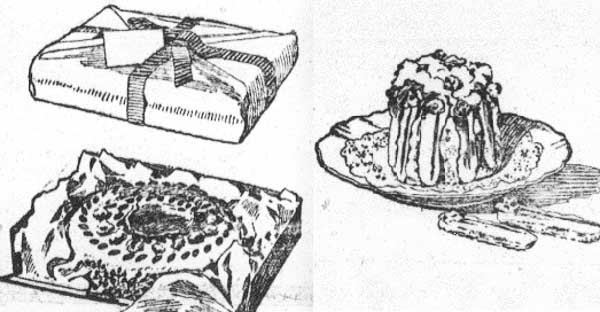
Violet Charlotte Russe
‘Cover the flat side of a dozen lady fingers with confectioner’s icing and decorate each with a candled violet and a long stem cut from candied angelica root. The angelica will cut more easily if it be first softened by standing ten minutes or more in boiling water. With these line a tall, round mold (a three pint tin pail is of just the right height). Fill the mold with either of the following fillings. Garnish the top with the whip from a cup of thin cream drained and stiffened by standing on ice and a few candied violets. The mold may stand twelve hours or more, but the violets with which the lady fingers are decorated will be in better condition if the mold be chilled quickly, in about an hour.
Grape Juice Filling. Soften a scant half package (one ounce) of gelatin in half a cup of grape juice and when thoroughly softened dissolve in three-fourths a cup of hot grape juice. Add three-fourths a cup of sugar and the juice of a small lemon and stir until the sugar is dissolved. Then strain into a pan set in ice water. Stir until the mixture begins to thicken. Then fold into it gradually the whip from one pint of cream drained and chilled.
Violet Filling. ln the above recipe substitute for the grape juice unwhipped cream tinted with violet color paste and flavored with a teaspoonful of violet extract or use a teaspoonful of pistachio extract or one teaspoonful of vanilla and half a teaspoonful of lemon extract.’ (Sotoyome Scimitar, 1904)
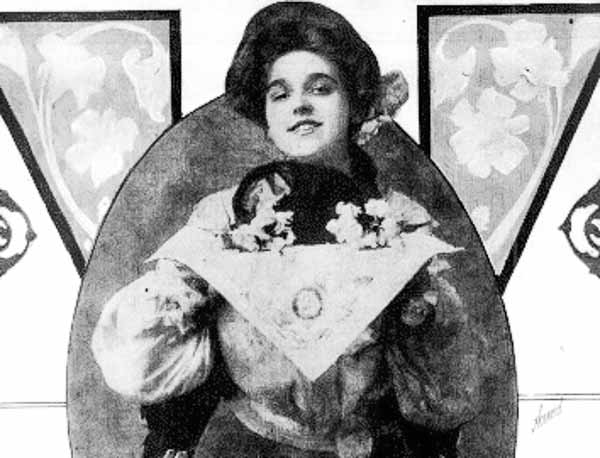
Chocolate Egg With Cream Filling
‘The immense candy egg is not an impossible thing these days and you can easily make one for yourself, an egg of chocolate with a very fine cream filling.
To make a chocolate egg for Easter take the white of an egg and an equal quantity of cold water. Beat well together. Now add a little vanilla flavoring. Take two pounds of confectioner’s sugar and stir into the egg mixture. Keep on stirring, until the whole is like brocaded velvet, stiff enough to stand alone.
Now comes the critical test. Take the dough and mold it in the fingers, which can be well sugared to prevent it from sticking. Mold and mold until you have a great mass, egg shaped and as big as a loaf of bread. The egg should be almost the size of your head, but it should be egg shaped, not round.
Now, melt some sweet chocolate on the stove and, when it is very soft, roll the big egg in it until you have a chocolate egg. This when cold will be a chocolate egg worth looking at.
Very thin slices of this chocolate egg can be served with cake. It is excellent with ice cream and coffee. Or, again, it is good as an evening refreshment. It is good form to serve it with crackers and chocolate. In which case it makes a very nice dish indeed.’ (San Francisco Call, 1904)
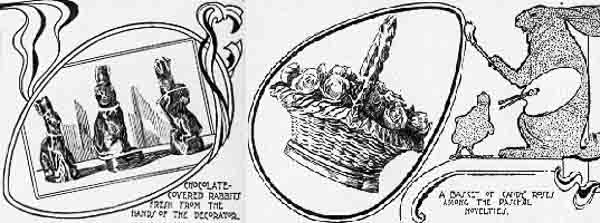
Easter Candy
‘A wonderful basket of roses, made entirely of candy, with candy leaves outlining the edge of the basket and the handle, is found among this year’s Easter novelties. […] The curious little moulded rabbits and other candy animals considered indispensable at the Easter season are not merely moulded animals when they leave the hands of a skilled artist, but real work of art; and the huge candy eggs give ample surface for a display of his talent.
Germany is the real home of the candy artist. There one is compelled to give four years of the most thorough painstaking study before this trade – if one can call the development of such artistic talent a trade – is considered complete. […]
First, on the dark glossy surface of the chocolate-covered egg, or the tinted surface of the cream-dipped egg, this champion candy decorator will trace a delicate sky background with water color paints; then just beneath the horizon line will appear a misty outline of fields and meadows, with a cozy farmhouse nestling in the midst. Then the water color paints are laid aside, and the tinted frostings are taken up for the relief work. Green trees will stand out in relief in the foreground, arranged with deft touches by the use of delicate green frosting applied from the tip of a paper-cone; within the branches of these trees tiny birds’ nests will appear, each holding four little eggs. Then hovering about the tree tops are tiny birds, with wings outspread, standing out in relief. On the ground beneath the tree will be found the indispensable Easter rabbit, and often the hunter and his dogs will appear in most realistic form, gayly hunting the seasonable bunny.
Only the pure vegetable colorings are used to tint the frostings, which are applied by pressing through cornucopias instead of being painted with a brush. It is claimed by modern manufacturers that by the use of these pure vegetable colorings every ingredient used in the decoration of the candy novelties is pure enough to be eaten by the child to whom these works of art are presented at the Easter season.’ (Los Angeles Herald, 1 April 1906)
‘For five cents some very attractive candies are shown. For instance, a little yellow chick has his head just out of a chocolate egg […] Another one is in the form of a chocolate egg-cup, the egg being of white fondant, with a name of the recipient written across the front.
Jack rabbits and bunnies in white and chocolate, with brilliant pink eyes, abound in varied sizes, selling from three to fifty cents apiece. Roosters are not to be forgotten, and some are attached to small conveyances. Another idea sure to please the children is a wee nest of spun sugar, filled with candy eggs, some speckled, some plain.
A charming favor is a tall stork supporting a nest of twigs filled with eggs. Another is a Jack rabbit dressed in brave attire carrying a basket bearing a large egg. Eggs of all sizes are seen of fancy paper filled with sweets and tied with ribbons. All sorts of fanciful articles are called into play and filled with the inevitable Easter sweetmeats. The average child is likely to gorge himself with these palatable good things, so the wise mother will keep certain standard remedies that will correct this superabundance of sugar.’ (Los Angeles Herald, 15 April 1906)

Ice Cream
‘Ices in the form of eggs reposing on a nest of spun sugar is one of the most attractive ways of offering them. They may be had of different flavors, vanilla, orange or lemon ice, pistachio and strawberry are general favorites.
There are a number of attractive paper cases for serving ices. One in the form of a yellow tulip is very suggestive. An ice in the form of an Easter lily is most charming, but expensive, and seemingly too attractive to demolish. […]
A most palatable novelty in ices that will surely interest the Easter hostess is a coffee parfait with crystallized mint, candied roses or violet leaves. The parfait is easily prepared.
Cook a cup of sugar and one of water until it spins a thread, then slowly beat it into the whites of three eggs; beat until quite stiff. When cool, put in a cup of excellently made strong coffee. The blend should be of the very best coffee. Continue to beat and when the mixture is cold, fold in a pint of cream, whipped until firm. Place the whole in a pail or suitable receptacle with greased paper over. Add a tight cover to exclude the air and bury in ice for four or five hours.
Serve in sundry glasses and sprinkle lightly with candied mint leaves, violets or rose petals. This will be found a most attractive dessert and one approved of by fashionable hostesses.’ (Los Angeles Herald, 8 April 1906)
Jelly Orange Wedges
‘One pint of orange-juice. The juice of four lemons. Six ounces of loaf sugar. Two ounces of leaf gelatine. One pint of water. Cochineal.
Put the water and sugar in a clean pan, add the thinly pared rind of six oranges, and the gelatine. Let these cook slowly on the fire until the gelatine is melted, and the colour and flavour are well out of the orange rinds.
Well wipe some unpeeled oranges, cut in half roundways, and with a teaspoon carefully remove all the inside, leaving a case of peel.
Strain a pint of orange-juice and the lemon-juice into the gelatine, etc. Arrange the cases of peel in a baking-tin or box, so that they will keep upright; it is often necessary to pack them round with soft paper.
Pour half the jelly into a basin, and colour it a pretty red with cochineal. Fill some of the orange-cases with red jelly, the rest with yellow. Leave them until quite set. Then take a sharp knife, dip it in hot water, and cut each filled case in half, making sippet-shaped pieces. Be careful not to drag the knife through the jelly, otherwise it will have jagged edges. Arrange the sippets among natural leaves on a pretty dish.
N.B. – If time is an object, the jelly may be set in a mould, but, of course, it will not be so effective in appearance.’ (Every Woman’s Encyclopaedia, 1910-2)
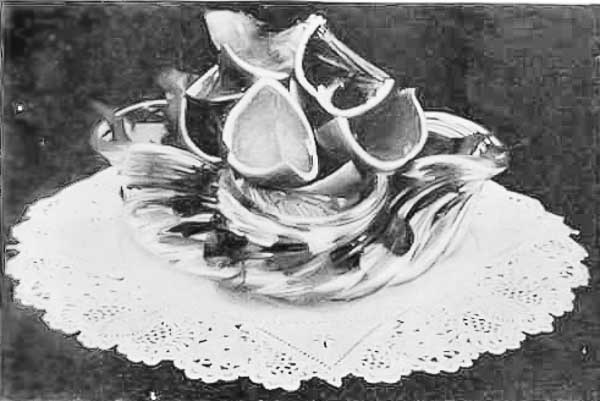
Jelly Easter Eggs
‘A pretty dish of Easter eggs may be prepared as follows: Pour one pint of cold water over one ounce of gelatine, and let it steep for four hours; add one pound of sugar and three pints of boiling milk, and stir over the fire until the sugar and the gelatine are quite dissolved; then strain and divide into four parts. Stir into one part two tablespoonfuls of sweet vanilla-flavored chocolate; into another the beaten yolks of two eggs; a little prepared cochineal or very red fruit syrup into the third, and leave the fourth white. Flavor the white with rose-water, the red with essence of almonds, the brown with vanilla, and the yellow with essence of lemon. Put the yellow portion over the fire and let it heat long enough to cook the eggs, stirring continually. Have a dozen egg-shells ready, emptied through a very small hole made at one end of the shell, and rinsed well in cold water, changing it several times. Do not drain or dry them, as the insides must be quite wet when the shells are filled. Fill three shells with each of the mixtures, standing them upright in a pan of flour or finely-powdered salt, and let them remain all night. On the following day fill a glass dish three parts full with white wine jelly cut in pieces, and on this arrange the eggs, having first peeled off the shells. Scatter among them candied orange and citron peel cut into thin shreds.’ (The Cook Book By “Oscar” Of The Waldorf, 1896)
Interesting post and things that we could try. I have always been interested in history and love the fact that these old recipes are being kept alive. #dreamteam
Thanks, Sophie! 🙂
Some lovely old fashioned recipes here thank you for linking to #cookBlogShare
Thanks for stopping by, Jacqui! 🙂
Fascinating post!
Thanks, Barbara!
Lovely post setting all sorts of creative ideas off in my mind. #MMBC
Thanks, Kate! 🙂
They all sound delicious! Thanks for sharing with SYC.
hugs,
Jann
Thanks for stopping by, Jann!
This is a very interesting post! Hope you are having a great weekend and thanks so much for sharing your great post with us at Full Plate Thursday!
Miz Helen
Thanks, Helen! Have a great weekend too!
Such fun recipes! I love to read these old articles. Thanks for sharing on Foodie Friday!
Thanks, Julie!
This was really fun to read, thanks for sharing 🙂
Thanks, Chas! 🙂
Those jelly eggs must have been really sweet with a pound of sugar! Thanks for sharing at the Blogger’s Pit Stop! Can’t wait to see what you link up next week! Roseann from This Autoimmune Life
Old recipes are usually quite sweet! 😉 Thanks for stopping by, Roseann!
I love reading historic recipes – and then trying them! Thanks for sharing at the What’s for Dinner party!
Thanks, Helen!
I was so interested to read more about Victorian and Edwardian Easter desserts! I love how they were so fascinated with violet and rose – and I always enjoy those flavours. So interesting that they used Cochineal back then as well. Thank you so much for sharing this wonderful post at the Hearth and Soul Link Party, Lina!
Thanks, April! Yes, the violet recipes sound so interesting!
I so enjoy reading old recipes! Thanks for sharing with Party in Your PJs!
Thanks, Lynda!
These old recipes are delightful. I remember my grandmother cooking so much with gelatin when I was young, but my boys aren’t interested in that kind of food! I want to try these recipes, though. So much fun!
Let me know how it tastes if you try one of the recipes! 🙂
Interesting old fashioned recipes, great for sharing with us at Fiesta Friday
Thanks, Petra!
Congratulations!
Your post is featured on Full Plate Thursday this week. We will be pinning your post to our features board and hope you enjoy your new Red Plate!
Miz Helen
Thanks for featuring me!